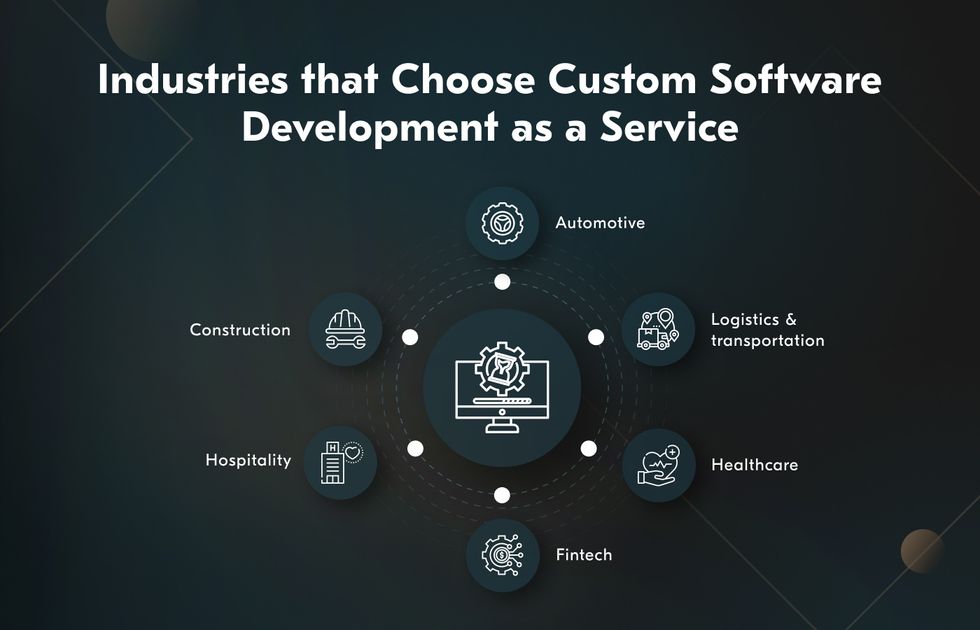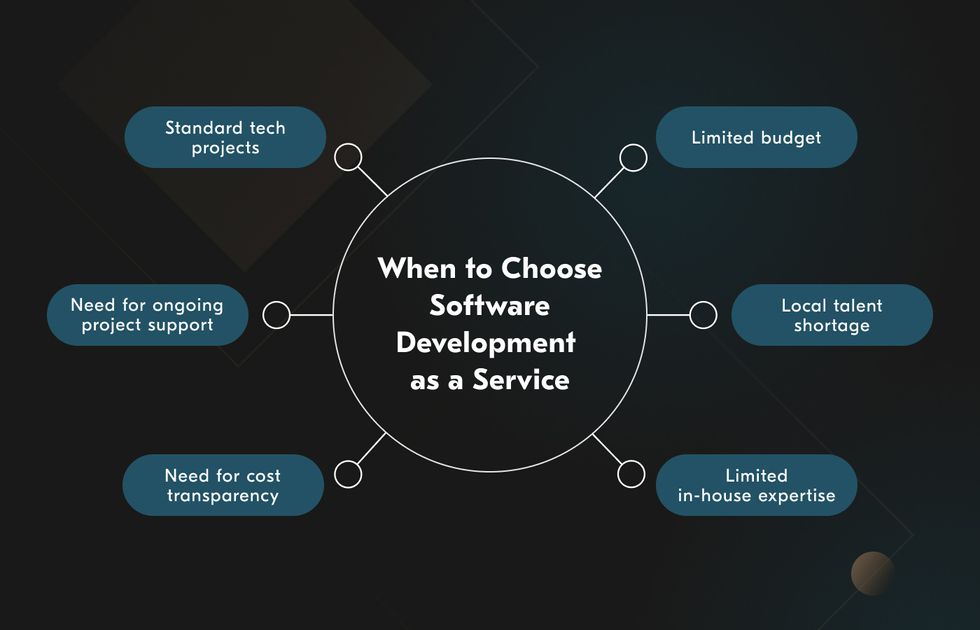
Key Takeaways
- The Software Development as a Service (SDaaS) subscription model provides access to a full development team, including project managers, business analysts, software engineers, and QA experts, without needing to hire in-house.
- Subscription-based cooperation combines the benefits of a dedicated team with the predictability of a fixed-price model, offering clear monthly costs similar to paying employee salaries.
- Hiring a tech employee takes about 36 days, excluding onboarding, making it resource-intensive to assemble a development team from scratch. In contrast, an SDaaS contractor provides immediate access to needed experts.
- In the US, middle software engineers average $147,524 annually, but by subscribing to development solutions, you can hire equally skilled Ukrainian developers for about $54,000 a year.
A growing pile of unplanned changes and unforeseen pitfalls multiplied by unrealistic deadlines that quietly eat up your budget. Yes, software development projects are no piece of cake. It doesn’t take much to blow the development process off the course. And it doesn’t even matter whether you outsource or develop the product in-house—these challenges don’t seem to discriminate. Or do they?
The Custom Software Development as a Service Subscription model will make you immune to most development hardships. Through years of developing business-centric software solutions, Acropolium has formed unique subscription-based cooperation terms where our clients subscribe to their success.
But how do you… ”subscribe” to IT services? Today, we’re breaking down the ins and outs of subscription models to help you understand what form of cooperation will work better for your business.
What is software development as a subscription model?

Software Development as a Service refers to a business model where software development services are offered on a subscription basis rather than a one-time purchase or project fee.
For example, if you don’t have the necessary expertise to build an app for your e-commerce business in-house, there’s no need to make any hires yourself. A SDaaS vendor will provide you with a project manager, a business analyst, software engineers, a QA expert, or whatever expertise you need.
They’ll work on your custom software full-time to conceptualize the solution based on your needs, implement it, and make all the necessary updates post-release. You don’t need to assemble a team, pick technologies, or bother with making unexpected hires in the middle of the project. A SDaaS vendor will take care of everything based on your project specifications. A fixed monthly fee is all it takes.
And ideally, this monthly fee is not just made up. It’s a perfect ratio of price to value. No bloated teams, paid idle times, or overtimes—using the SDaaS model means you pay only for the result.
Now that you know what’s behind the web development subscription concept, let’s take a closer look at its main benefits.
The benefits of the Software Development as a Service Subscription model

Custom software development as a service brings together the merits of a dedicated team and the predictability of the fixed-price approach. You know exactly how much you’ll need for your project every month. It’s very similar to paying a monthly salary to your employees.
At the same time, the SDaaS model is way better than in-house development. It promises the freedom and flexibility of an outsourcing setup. And this is just the cherry on top. Here are more advantages of SDaaS.
Cost-efficiency
When running an in-house team, there’s no guarantee that your employees produce maximum results for the money you pay them. Especially if they have little to no experience with similar projects. They might flip-flop between different technologies in search of the best fit. Or they might be new to certain tools, frontend/backend frameworks, or languages needed for your project and spend extra time learning. And that’s to say nothing about superfluous roles in your team.
With a reliable SDaaS provider, your monthly subscription will cover only the functions needed for your project and hours dedicated to its implementation—nothing else. What’s more, you will always know what you get at the end of each month. Software development as a service is predictability at all levels.
No hiring
On average, it takes about 36 days to hire one (!) tech employee, and this figure doesn’t cover onboarding. Given that you’ll need about 4.5 months to build a new software product, assembling a development team from scratch on your own is a pure waste of resources, especially if you don’t have experts in-house who can screen technical candidates.
Based on your requirements, a SDaaS contractor will instantly provide you with the needed experts who can get down to work straight away. On top of that, you can easily scale your team up or down even when your project is in full swing.
Access to global talent
Outsourcing in all its forms is a true portal to the wealth of global expertise for both startups and large enterprises. It gives you a chance to find the world’s top talent wherever you are. Along with the opportunity to lower the costs and implement a top-notch product, you’ll be able to reach out to the otherwise inaccessible global talent.
Case in point, Alibaba turned to outsourcing, facing a lack of the needed talent in China. The company wanted to localize its website for the English-speaking audience and compete with giants like eBay despite the internet restrictions in China. Thanks to an outsourcing vendor from the US, Alibaba is now a household name.
Cost reduction
Deloitte’s global survey revealed that 30% of companies worldwide use software development outsourcing as a key delivery model. Why? First, with in-house implementation, you will have to invest in all the hardware and software necessary for your project—and most likely, at some point, you’ll find yourself spending on things that are seldom (if ever) used. With a web development subscription, it’s all on your vendor.
Second, software developers as a service, just as other outsourcing models, allows you to hire the most affordable talent. Let’s assume you operate in the US, where middle software engineers make $147,524 a year on average. Within the SDaaS setup, you can hire, say, Ukrainian developers with the same level of expertise, which will cost you considerably less—$54,000 annually. As a result, you’ll reduce your expenses by 2.9 times without compromising quality.
Faster time-to-market
With the SDaaS model, you don’t need to hire the missing talent on your own—your provider will urgently supply you with the necessary expertise with no need for onboarding at any project stage. This model also safeguards you against veering between different technologies and settling on the wrong one. Finally, with a reliable SDaaS vendor, you may rest assured that every single hour your dedicated team spends on your project takes you closer to release. So yes, SDaaS accelerates your time to market.
Scalability and risk mitigation
SDaaS provides the ability to quickly and efficiently scale development resources up or down based on the evolving needs of the business, ensuring that projects can adapt to changes in demand without the burdens of hiring or downsizing staff.
This flexibility allows businesses to sustain market changes , new opportunities, or unforeseen challenges, maintaining momentum and agility. Additionally, software subscription models help mitigate risks associated with project delivery by leveraging the expertise and established processes of the service provider.
The provider’s experience and specialized knowledge reduce the likelihood of errors, delays, and cost overruns, offering a more reliable path to successful project completion.
Types of development projects suited for SDaaS

SDaaS model is particularly well-suited for various types of development objectives, providing unique advantages through its subscription model:
- For SaaS platforms, the continuous need for updates, maintenance, and feature additions is well-supported by SDaaS. The subscription model offers regular and predictable costs, allowing for quick scaling of resources as the platform grows while ensuring consistent access to skilled developers.
- In startup development, where high uncertainty and rapid prototyping are common, development as a service provides the flexibility needed for frequent pivots. It offers cost efficiency during initial stages and the agility to respond swiftly to market feedback.
- Niche technology development, which requires specialized knowledge and ongoing innovation, benefits from the SDaaS model by giving access to a large pool of experts without long-term. This model supports regular updates and integration of cutting-edge technologies.
- E-commerce platforms, with their need for constant updates, security patches, and feature enhancements, find SDaaS advantageous. The subscription model ensures regular updates to meet changing customer expectations, scalability during peak seasons, and continuous support and maintenance.
- For MVP development, rapid development and iterative improvements based on user feedback are essential. Software development as a service offers a cost-effective approach with the ability to scale resources up or down as needed, facilitating quick iterations and continuous improvement post-launch.
- Legacy system modernization involves gradual migration and integration with modern technologies. Subscription models spread out costs over time, allowing for a phased approach that minimizes risks and ensures continuous support during and after the transition.
- Mobile app development requires frequent updates, platform compatibility, and feature enhancements. SDaaS will guarantee regular updates and bug fixes, maintains compatibility with new OS versions, and offer a cost-effective way to scale development efforts.
- In data analytics and business intelligence, continuous data integration, analysis, and insights generation are crucial. The subscription model allows for regular updates with new analytical tools and techniques, scalable resources for handling large data sets, and ongoing support for evolving business needs.
- When it comes to enterprise app development, software subscription models ensure continuous development and integration support. At the same time, they offer scalability to meet growing enterprise needs and regular updates to maintain compliance and security standards.
Industries that benefit from 3rd-party development support

Subscribing to development allows companies to leverage specialized expertise, reduce costs, and accelerate project timelines. Here are some of the key industries that grow with the power of SDaaS and the reasons why they choose to outsource:
- The automotive industry is highly dependent on advanced software for autonomous driving, connectivity, and vehicle management systems. Third-party developers provide the necessary expertise in cutting-edge solutions like AI/ML and IoT, enabling automotive companies to integrate sophisticated systems without diverting focus from their core manufacturing processes.
- With the need for real-time tracking, route optimization, and fleet management, logistics and transportation companies require robust and scalable software solutions. Outsourcing development allows these companies to access specialized skills in big data analytics, GPS technology, and cloud computing, ensuring efficient operations and improved service delivery.
- The healthcare industry demands highly secure and compliant software solutions for patient management, telemedicine, and electronic health records. Third-party developers bring in regulatory compliance (such as HIPAA), cybersecurity, and advanced technologies for diagnostics and treatment planning, helping healthcare providers deliver better patient care.
- To elevate guest experiences and boost operations, the hospitality industry needs sophisticated software for booking systems, customer relationship management, and mobile apps. By delegating the development process to a dedicated team, hotel businesses implement innovative solutions quickly, providing a sharper competitive edge where customer satisfaction is paramount.
- Fintech companies require secure, scalable, and progressive financial solutions, including mobile banking apps, payment gateways, and blockchain technologies. Outsourcing vendors offer specialized knowledge in financial regulations, security protocols, and emerging financial technologies, helping businesses stay competitive.
- The construction industry benefits from software that enhances project management, resource allocation, and on-site safety. By opting for development as a service, construction companies can implement building information modeling (BIM), IoT for smart construction sites, and mobile solutions for fieldwork, improving efficiency and project outcomes.
When you should use Software Development as a Service Subscription model

Despite all its advantages, web development subscription is no panacea and doesn’t cover all the cases. Here’s when we recommend using this model instead of going for other outsourcing approaches or building the product in-house:
- You are short on budget. In most cases, development as a service, as well as other outsourcing approaches, will cost you less than in-house development for a variety of reasons.
- You don’t have the needed talent in your area. SDaaS gives you access to expertise overseas.
- You don’t have the available talent in-house. If you need only one or two employees, it probably makes sense to hire them on your own, especially if you need them for a long time. But when it comes to a full-fledged team, it might be best to “subscribe” to one as part of the SDaaS package.
- You need a guarantee on your spending. Most often, you need to know exactly how much you’ll spend over the following months. That’s where SDaaS comes in handy.
- You have a standard tech project. Most software projects are similar in terms of roles and implementation time. Development as a subscription package covers a predefined set of functions needed for a basic project. If your requirements go beyond this scope, consider outsourcing approaches that offer more flexibility.
- You need someone to support your project post-release. Many software development vendors offer implementation only, shifting support and maintenance on the client’s shoulders. Within the SDaaS setup, your dedicated team will keep your product up and running, adjusting it to the market needs.
Based on our experience, the subscription model covers the needs of most projects. But before you take the leap into the SDaaS market searching for a suitable vendor, make sure you actually need to develop anything at all.
Service-based or product-based software provider: what to choose?

According to research by GoodFirms, a custom software solution will cost you up to $120,000+. This price stings, especially if you’re just getting started and require fully tailored website development for your brand. Luckily, in some cases, you don’t need to look for a service-based development partner who can build a custom solution for you.
Alternatively, you can find a product-based software provider with an off-the-shelf solution. Specifically, if you need a solution for internal use, and there’s a suitable one available on the market. You don’t want to develop a video conferencing tool from scratch if Zoom meets all your needs. But in case there are no relevant offerings, custom development is your way out.
Acropolium’s approach

You’ve probably come across Acropolium on the Clutch top listings. With a 20-year background, we work miracles with AI, big data, cloud computing, blockchain, chatbots, and other in-demand technologies. We take pride in hundreds of successful projects across industries, from retail to logistics. All in all, we can handle anything a tech project typically entails.
Of course, we support different outsourcing models, including SDaaS. Our monthly package covers audit, consulting, development, testing, support, and modernization—the functions any full-fledged product development requires. Here’s how this offering stands out from the competition:
- We do not overcharge. Every cent of the monthly fee counts.
- We guarantee the quality of the delivered product. Each completed task undergoes a three-phase review when a first-class engineer reviews any changes. We use only up-to-date libraries and frameworks.
- Your needs are our priority. Though our SDaaS package is standard, the end product always addresses individual client needs. At the outset, we’ll thoroughly audit your case, analyze your requirements, and provide development estimations. Then we’ll guide you on any possible risks and how to mitigate them and brainstorm an informed solution.
- You choose your level of control. With Acropolium, you can track your project status 24/7 and reach out to your dedicated SDaaS team whenever you need to. You’ll also get monthly activity reports. At the same time, you don’t have to actively participate in the project if you don’t want to—you can focus on your core tasks while we handle the tech side.
- We cherish long-term relationships. Many vendors guarantee product maintenance and modernization for only 3-6 months after release. Rest assured here, we’ll be with you as long as you need. About 60% of our clients have been cooperating with us for over a decade, building a successful, long-term development partnership.
At the same time, with Acropolium, you are not locked in our subscription. We are flexible. So if you need expertise not covered by our package, we’ll set up our cooperation in a way that works for you.
Final thoughts
The Software Development as a Service model offers advantages that other IT outsourcing approaches do not. Among the most attractive ones are predictable ongoing costs, result-based pricing, and guaranteed product maintenance and enhancement post-release.
But let’s not forget that you still depend on a third-party vendor. If you choose an incompetent one, you risk flushing your budget on a low-quality product. That’s why it’s paramount to stick to a reliable partner. Acropolium, with almost two decades of successful projects under its belt, offers you subscription-based cooperation with your budget being a priority. Whether you want us to consult on your case or bring your idea to life, just contact us.









![E-commerce App Development: [2025 Guide]](/img/articles/the-a-z-guide-to-e-commerce-app-development-benefits-features-and-cost/img01.jpg)

![How to Reduce Software Development Costs [6 Effective Tips]](/img/articles/reduce-software-development-costs/img01.jpg)
![ᐉ How to Hire Dedicated Backend Developers [2025 Guide]](/img/articles/find-backend-developers/img01.jpg)
![How to Scale a Software Product [9 Working Tips]](/img/articles/scale-software-product/img01.jpg)
![Custom Software Development Cost Estimation [2025 Guide]](/img/articles/software-development-project-estimation/img01.jpg)